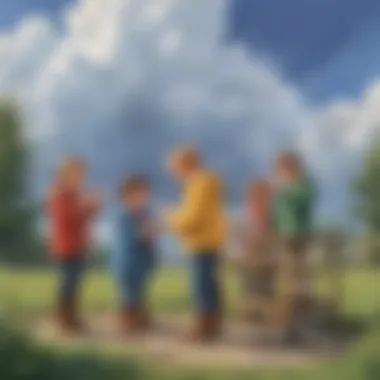Exploring Engaging Weather Science Experiments


Intro
Weather is more than just a daily forecast. It is a complex system that affects living beings and the environment. Understanding weather phenomena is essential for both researchers and the public. For young learners, engaging in weather science experiments can foster an early interest in meteorology and environmental science. This guide is geared towards children aged six to twelve. Here, we will cover various experiments, helpful tips, and emphasize safety.
Learning about weather through hands-on activities enables children to grasp concepts better. It also allows parents and educators to interact meaningfully with young learners, making science fun and relatable.
Science Fun Facts
Weather science is full of fascinating insights that can spark curiosity. Here are some interesting trivia and facts about weather that young scientists may find captivating:
- Did you know? The highest temperature recorded on Earth was 134°F (56.7°C) in Furnace Creek Ranch, California.
- Rain drops are not teardrop-shaped. They are actually shaped like tiny hamburger buns!
- Lightning strikes the earth about 8.6 million times each day, that’s about 100 times every second!
- The windiest place on Earth is Commonwealth Bay in Antarctica. Winds have been recorded over 200 miles per hour!
These facts can stimulate discussions and encourage children to ask more questions about weather.
"Curiosity drives science. By nurturing inquisitiveness, we develop future thinkers and problem solvers."
Discover the Wonders of Science
Once kids are intrigued by weather facts, it's time to dive deeper. Exploring various scientific concepts related to weather can enhance their understanding. Here are some interactive resources:
- Educational Videos: Platforms like YouTube have hundreds of videos explaining weather phenomena.
- Animations: Websites such as Britannica offer animations that visually depict how weather systems work.
- Interactive Learning Tools: Apps like Weather Wiz Kids provide fun facts and quizzes about weather.
- Real-Life Applications: Discuss how weather affects agriculture, travel, and daily activities.
These resources can help bring the concepts to life, demonstrating how they apply in real-world scenarios.
Science Experiment Showcase
Engaging experiments allow children to see the science behind weather firsthand. Here is a selection of fun experiments:
Fun and Engaging Experiments
- DIY Tornado in a Bottle
Create a mini tornado using two plastic bottles, water, and duct tape. When you swirl the bottles, it creates a tornado effect inside. - Make Your Own Rain Cloud
Use shaving cream to simulate a cloud and drop food coloring on top. The result visualizes how rain forms.
Step-by-Step Instructions
- Tornado in a Bottle:
- Rain Cloud:
- Fill one bottle with water (leave some space).
- Tape the second bottle over the first.
- Flip and swirl.
- Fill a clear glass with water.
- Add a layer of shaving cream on top.
- Drop food coloring onto the shaving cream and watch it "rain".
Materials List
- For the tornado:
- For the rain cloud:
- Two plastic bottles
- Duct tape
- Water
- Clear glass
- Shaving cream
- Food coloring
Safety Tips and Precautions
- Always supervise children during experiments.
- Ensure that materials used are safe and non-toxic.
- Wear safety goggles if necessary.
These experiments are simple yet effective ways to engage children in weather science.
Prologue to Weather Science
Understanding weather is a fundamental aspect of our daily lives. Weather science encompasses the study of atmospheric phenomena and helps explain the unpredictable nature of our environment. By diving into this topic, young science enthusiasts can grasp essential concepts that will aid in their comprehension of how weather operates.
Weather patterns can dictate various occurrences, from planning a picnic to predicting severe storms. Knowing how to observe and analyze weather can foster an appreciation for nature and the environment. Furthermore, curiosity about the weather can spark a lifelong interest in science.


Understanding Meteorology
Meteorology is the science that studies the atmosphere and its phenomena. It includes analyzing the atmosphere's behavior, predicting weather patterns, and understanding climate change impacts. Children as young as six can start learning basic meteorology concepts. They can explore topics such as temperature changes, humidity levels, air pressure, and wind movements through engaging science experiments.
Grasping meteorological principles allows kids to interpret weather forecasts better. For instance, observing clouds can help distinguish between various weather conditions. Making weather predictions enhances critical thinking skills. By exploring meteorology, kids gain an appreciation for scientific inquiry and the power of observation.
Importance of Weather Experiments
Engaging in weather experiments is critical for enhancing understanding and fostering curiosity. These experiments provide hands-on learning opportunities. Children can see firsthand how weather phenomena work, making the learning process more effective.
Some key benefits of conducting weather experiments include:
- Practical Learning: Experiments offer practical knowledge that can be applied to real-world scenarios. Children learn through direct experience, which reinforces their theoretical understanding.
- Observation Skills: Weather experiments encourage keen observation. Children note details, analyze results, and refine their skills, which can be beneficial in all areas of science.
- Critical Thinking: Engaging in experiments promotes critical thinking. Children must make hypotheses, test them, and interpret the results, which exercises their analytical skills.
"The capacity to observe and experiment is vital for young learners, introducing them to the world of science through weather."
Finally, these activities help cultivate excitement about science. Children become more invested in the subject as they witness how science applies to the world outside. Engaging in weather science also allows parents and educators to bond with children, encouraging teamwork and shared exploration.
Essential Weather Elements
Understanding essential weather elements is crucial for grasping weather science. These components create the foundation for meteorology and help explain various atmospheric phenomena. Each element plays a unique role in how weather is formed, influencing not only local climates but also larger weather patterns around the globe. Recognizing these elements allows young learners to engage meaningfully with their environment and encourages critical thinking through observation and experimentation.
Temperature
Temperature is a primary indicator of weather. It measures how hot or cold something is and is typically expressed in degrees Celsius or Fahrenheit. By observing temperature changes throughout the day, children learn to appreciate the variations in weather. For example, they can track daily temperatures and analyze how they correspond with other weather conditions, such as sunshine or rain.
Benefits of Understanding Temperature:
- It helps explain how warmth affects wind and precipitation.
- It promotes awareness of seasonal changes and climate.
- It encourages hands-on activities like building simple thermometers to measure temperature.
Humidity
Humidity denotes the amount of water vapor present in the air. It plays a significant role in weather conditions; higher humidity can lead to cloud formation and precipitation. When learning about humidity, children can perform experiments such as comparing how different environments affect moisture levels. For example, a jar with warm water can demonstrate evaporation compared to cold water.
Key Points on Humidity:
- It affects how we feel; higher humidity may feel hotter.
- It’s crucial for understanding weather forecasts.
- Understanding humidity helps grasp cloud formation and storms.
Air Pressure
Air pressure is the weight of the air pressing down on the Earth's surface. Changes in air pressure can indicate if the weather will be clear or stormy. Weather instruments like barometers measure air pressure and can be built simply at home. Parents and teachers can guide children through discussions about how air pressure influences wind, clouds, and storms.
Highlights of Air Pressure:
- High pressure generally leads to sunny skies, while low pressure may indicate storms.
- Observations of air pressure can teach prediction skills regarding weather conditions.
- It is a fundamental concept for understanding basic weather patterns.
Precipitation
Precipitation refers to all forms of water, liquid or solid, falling from the sky. This includes rain, snow, sleet, and hail. Observing precipitation allows children to connect weather changes with real-world outcomes, such as the need for umbrellas or snowmen. Tracking different types of precipitation can lead to discussions about the water cycle and its importance to ecosystems.
Important Aspects of Precipitation:
- It varies greatly by region and climate.
- It is essential for replenishing water supplies.
- Observing precipitation can foster discussions about climate change and its effects.
Wind and Its Forces
Wind is simply moving air and is created by differences in air pressure. Understanding wind helps children explore its effects on weather patterns, including storms and changing temperatures. Activities such as making a wind vane or flying kites can bring the concept of wind to life.
Understanding Wind Effects:


- It influences temperature, humidity, and precipitation.
- Observations of wind direction and speed can help predict weather changes.
- Exploring wind can enhance skills in measurement and observation.
By learning about these essential weather elements, children can grasp complex weather concepts much easier. Understanding the basic components of weather enriches their science education and connects them to the world around them.
Types of Weather Science Experiments
Understanding the types of weather science experiments is key to gaining insights into meteorological concepts. Each experiment offers unique insights into different weather elements. These activities are essential for young learners as they make weather science interactive and engaging. Hands-on experiments help solidify theoretical knowledge. They also make the learning process enjoyable, encouraging curiosity and exploration.
Basic Weather Observations
Basic weather observations are foundational. They involve tracking daily weather conditions like temperature, humidity, and wind direction. Using tools like thermometers or simple charts can help children record their findings. Regular observations can teach kids how weather changes over time. It introduces them to the concept of patterns in nature. These observations are important for developing critical thinking skills and attention to detail.
Making a Simple Barometer
Creating a simple barometer can be rewarding. This device measures air pressure, which is vital in weather forecasting. To build one, you only need a jar, a balloon, and a straw. First, stretch the balloon over the jar opening. Secure it with a rubber band. Then, place the straw on top of the balloon, extending outward. As air pressure changes, the balloon will move, and the straw will indicate the pressure level. This experiment is engaging and illustrates a fundamental principle in meteorology.
Creating a Rain Gauge
A rain gauge measures precipitation accurately. This is a straightforward project and provides immediate results. To create one, use a plastic bottle or jar and place it outside. Mark the measurements on the side. After rain, children can measure how much water has collected. This activity introduces crucial concepts about rainfall and its effects on the environment. It encourages observation and data collection, which are essential scientific skills.
Temperature Tracking through Experiments
Tracking temperature through experiments helps children understand heat and its variations throughout the day. A simple experiment involves placing two thermometers in different locations, such as sunlight and shade. Over time, children can observe differences in temperature. This helps in understanding how the sun affects local weather conditions. Discussing temperature variations enhances knowledge about climate and environmental science.
Wind Vane Construction
Building a wind vane is another exciting project. This device shows wind direction, which is crucial in weather forecasting. For this experiment, use a plastic bottle, a straw, and a paper arrow. Poke a hole in the bottle cap and insert the straw to allow it to rotate. The arrow should point in the direction from which the wind is coming. This project combines creativity with science and provides practical knowledge about wind patterns.
Cloud Observation and Identification
Clouds are fascinating subjects for observation. Children can learn to identify different types of clouds, like cumulus or stratus. A cloud chart can help with this process. Set specific times to observe clouds and document findings. Discussing various cloud formations connects directly to weather prediction and atmospheric conditions. This activity promotes outdoor exploration while reinforcing observational skills.
Thunderstorm Simulation
Simulating a thunderstorm is exciting and educational. Using a clear plastic container, water, and ice, children can create a storm effect. By heating the water and placing ice on top, they can observe condensation and evaporation. Darkness and sound effects can heighten the experience. This experiment teaches about storm formation and provides a safe platform to explore severe weather.
Tornado in a Bottle
Creating a tornado in a bottle is a thrilling experiment. It requires two plastic bottles and water. Fill one bottle with water, attach it to the empty one with duct tape, and swirl the water. A vortex forms, mimicking a tornado. This experiment illustrates how tornadoes develop and their dynamics. It engages children by demonstrating weather phenomena visually and practically.
Understanding Weather Patterns
Understanding weather patterns is crucial for predicting future conditions. Children can map out weather changes over weeks or months using simple graphs. By combining data from their previous experiments, they can analyze trends. This comprehensive approach provides a well-rounded understanding of how different elements interact in meteorology. It prepares them for further studies in environmental sciences.
"Weather experiments not only educate but also ignite a passion for science in young minds."
By engaging in these experiments, children contribute to their communities. Sharing findings can enhance local understanding of weather. Experiments create opportunities for collaboration and discussion, reinforcing the importance of scientific inquiry.
Safety Considerations
Safety considerations are a crucial aspect of conducting weather science experiments. When children engage with hands-on activities, it is essential to create a safe environment. Ensuring safety boosts confidence, encourages exploration, and minimizes accidents. Not only does it protect young scientists, but it also enhances the overall learning experience. It allows both parents and educators to focus on the educational objectives without worrying about mishaps.
Materials Considerations
Selecting appropriate materials is key to maintaining safety during experiments. When planning activities, consider the following:
- Non-toxic materials: Ensure that all items used are safe for children. Products for experiments should be free from harmful chemicals. For example, using water, salt, and vinegar for experiments is generally safe.
- Sharp objects: Avoid materials that have sharp edges. This can include glass containers or metal parts. Use plastic alternatives whenever possible.
- Age-appropriate tools: Make sure any tools or equipment are suitable for the age of the child involved. For younger children, consider using items like plastic measuring cups instead of glass.
- Secure setup: Set up the experiment in a stable environment. Ensure that all materials are placed securely to prevent them from falling over and creating hazards.
By taking these precautions, you can create a safer experimentation process for your young scientists, allowing them to explore and learn without fear of injuries.


Supervision Tips for Parents
Parental supervision plays a vital role in ensuring safety during weather science experiments. Here are some effective strategies:
- Be present: Always supervise the children closely while they conduct experiments. This ensures that they follow safety rules and procedures correctly.
- Educate about hazards: Before starting, talk about potential risks involved. Help them understand what to avoid and how to handle materials safely.
- Establish rules: Set clear guidelines on what behaviors are acceptable during the experiment. This may include rules about not running, not eating materials, and staying focused on the task.
- Encourage communication: Foster an environment where children feel comfortable asking questions. Ensuring they know they can seek help if unsure can prevent accidents.
By integrating these supervision tips, parents can enhance safety while enriching the learning experience during weather science experiments.
Analyzing Experiment Results
Analyzing experiment results is a crucial step in understanding weather science. This process not only helps to connect data with real-world weather phenomena, but it also allows participants to practice critical thinking and analytical skills. When children engage with these experiments, they learn how to collect, interpret, and evaluate data. This engagement provides a foundation for further exploring scientific concepts.
One benefit of analyzing results is that it fosters a sense of curiosity. Participants may wonder why certain outcomes occur. For instance, why did one type of precipitation have different measurements compared to another? Questions like these promote deeper understanding of weather elements and their implications.
Additionally, interpreting data aids in recognizing patterns and anomalies in weather. Recognizing patterns forms the basis of many scientific theories, which are vital in the field of meteorology. Understanding what the data shows about temperature changes or shifts in humidity creates a context for how these elements interact in the natural world.
Data Collection Techniques
Data collection is the first step to successful results analysis. Various techniques can be employed depending on the experiment.
- Manual Record Keeping: Participants can use notebooks to jot down observations daily. This allows them to track changes over time.
- Use of Simple Tools: Items like thermometers for temperature or rulers for rainfall can enhance data accuracy.
- Digital Apps: Some children might use weather apps to compare their findings with data collected from nearby weather stations.
Choosing the right technique depends on the resources available. However, hands-on methods often engage young learners the most, making them more invested in their work.
Interpreting Weather Data
Interpreting weather data requires practice and guidance. It is essential to learn how to read and understand the meaning behind the figures. Parents and educators can help children look for specific trends in their data. For instance, if a child observes that temperatures rise steadily each day, they can discuss what this could mean for local weather conditions.
When interpreting data, keep these steps in mind:
- Compare Results: Look at different sets of data. How do they relate? This could involve comparing data collected over different weeks or months.
- Analyze Changes: Understand how one element affects another. For instance, if humidity rises, how does that affect temperature?
- Draw Conclusions: Use the interpreted data to form explanations. An analysis may indicate patterns that are consistent with the seasons.
Analyzing and interpreting data helps bridge practical experiments with theoretical knowledge in meteorology.
Ultimately, the skills developed through analyzing experiment results prepare young learners for future scientific inquiries. By engaging with data, they develop a stronger connection to the field of meteorology and learn about the practical implications of what they discover.
Applications of Weather Experiments
Weather science experiments hold significant value in both educational and practical applications. These experiments not only build key understanding of meteorological concepts but also foster a connection between theoretical knowledge and real-world scenarios. By engaging in these activities, young science enthusiasts can observe and analyze the weather patterns that they experience daily. This active participation enhances their comprehension of complex topics such as climate variations and seasonal changes.
Real-World Connections
Linking weather experiments to real-world situations can greatly enhance a child's grasp of meteorological phenomena. For instance, observing local weather patterns can lead children to understand how changes in temperature or humidity directly affect their environment and daily life. This knowledge can assist them in recognizing the importance of accurate weather forecasts.
When young learners conduct simple activities, like tracking rainfall with a homemade rain gauge, they reflect on their own communities. They can compare their data with regional forecasts and understand how it contributes to local agriculture or disaster preparedness.
By observing and recording weather data, children gain insights that can foster responsibility and awareness about their environment.
Community Weather Monitoring
Community weather monitoring is another vital application of weather experiments. Encouraging children to take part in local weather initiatives can build a sense of community involvement. They can join or start a weather club at their school where members monitor and report local weather conditions together. Such activities promote teamwork, collaboration, and data sharing among peers.
In addition to this, these initiatives create opportunities for children to engage with local meteorological societies or community science projects. When children present their findings to adults or peers, it not only builds their confidence but also their ability to communicate scientific concepts effectively.
By applying their experiments to a community framework, children learn to respect the significance of collective knowledge and the role it plays in understanding weather. They can see how their contributions fit into larger discussions about climate change or environmental stewardship.
Culmination
Weather science is an essential field of study that contributes to our understanding of the world. Through experiments, children learn about various weather phenomena in a practical way. This article emphasizes engaging with science through hands-on activities, particularly aimed at young learners aged six to twelve.
By exploring weather-related experiments, children develop a sense of curiosity and critical thinking. They are introduced to important concepts such as temperature, humidity, air pressure, and weather patterns. These topics not only inform about everyday weather but also connect to larger global trends.
The benefits of conducting weather experiments are substantial. They foster a deeper comprehension of the natural world and prepare children for future academic pursuits. This experience enhances observational skills and encourages attention to detail, which are valuable traits in both scientific and everyday endeavors.
Furthermore, parents and educators play a key role in guiding these experiments. Ensuring safety and providing supervision are crucial factors that should not be overlooked. The knowledge gained through these experiments promotes scientific literacy and encourages community discussions.
"Experiments in weather science can ignite a spark in young minds, promoting a lifelong interest in how our planet functions."







